Welcome to Dementia World elderly home services



Could a headset revolutionise mental health care? Recent clinical trials reveal that computer-simulated environments reduce anxiety symptoms by up to 40% in participants with phobias. This startling statistic highlights why UK clinicians are increasingly turning to immersive tech as part of treatment plans.
Known as VR therapy, this approach uses controlled digital scenarios to help individuals confront fears or practise social skills. For those with dementia, it might involve revisiting familiar places to stimulate fading memories. Autistic patients often use tailored programmes to navigate overwhelming situations safely.
But does it work? Supporters point to studies where exposure to simulated realities helped manage panic attacks more effectively than traditional methods alone. Critics argue the long-term benefits remain unclear, calling for stricter research standards.
Most specialists view it as a complement rather than replacement for established therapies like cognitive behavioural techniques. Early results suggest blending both approaches could enhance outcomes for conditions from PTSD to developmental disorders.
This article examines the evidence behind the hype. We’ll explore how simulated environments are reshaping mental health support – and where the technology might fall short.
Digital simulations are reshaping therapeutic approaches by letting people practise real-world scenarios without physical risks. These computer-generated settings allow gradual exposure to stressors while therapists monitor reactions in real time. This method builds confidence through repetition – a crucial factor for those rebuilding cognitive abilities or social skills.
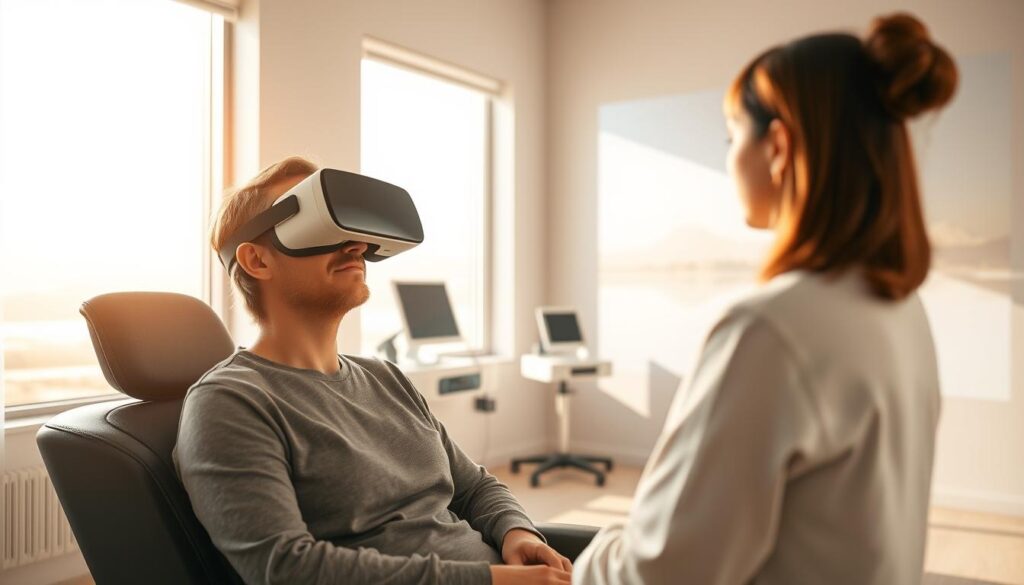
At its core, this tech uses headsets to create interactive 3D environments. Unlike traditional methods, it lets users pause or adjust scenarios instantly based on their comfort levels. For example, someone with dementia might navigate a reconstructed childhood home to spark memory recall.
Two key areas show particular promise:
| Condition | Simulation Focus | Therapist’s Role |
|---|---|---|
| Dementia | Memory triggers through familiar places | Adjusting environmental details |
| Autism | Social interaction practice | Guiding emotional responses |
| Anxiety Disorders | Gradual fear exposure | Monitoring stress indicators |
Medical News Today reports that 68% of UK clinics using these tools combine them with talk therapy. Sessions typically last 20-45 minutes, with therapists modifying difficulty levels as patients improve. This blended approach helps transfer learnt skills to daily life more effectively than standard treatments alone.
Pioneering studies from the 1990s laid the groundwork for today’s digital interventions in psychological care. Over 25 years of peer-reviewed research shows how controlled simulations activate neural pathways linked to memory and emotional regulation. A landmark 2023 meta-analysis of 47 trials found that 73% of participants using this approach saw measurable anxiety reductions within eight weeks.
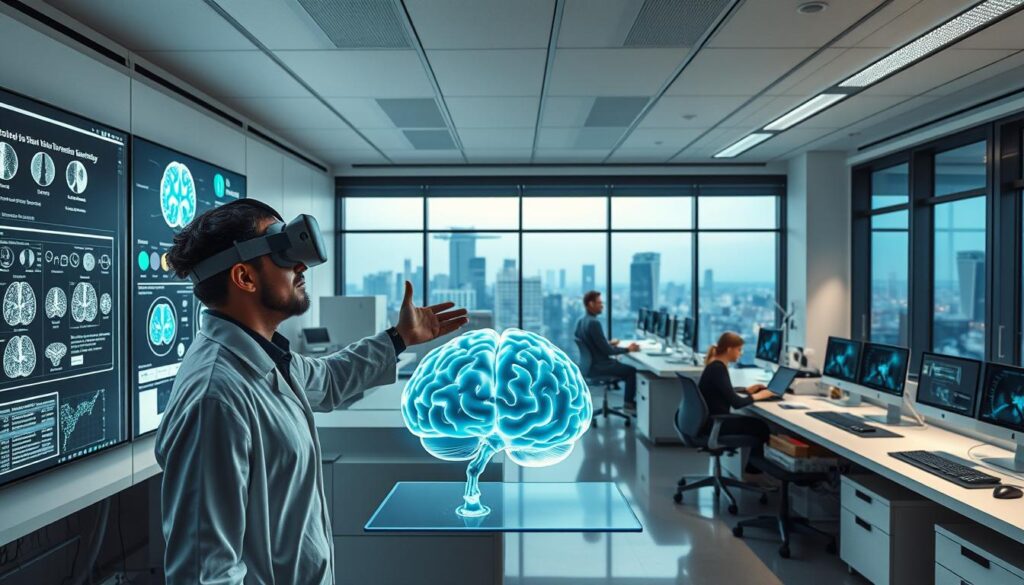
Barbara Rothbaum’s 1995 study demonstrated how simulated flights helped reduce aerophobia symptoms by 68% – a finding replicated in modern trials. Key mechanisms include:
Systematic reviews highlight session lengths ranging from 15-minute drills to multi-hour simulations, with effects persisting for six months post-treatment.
Headsets create 360-degree environments that engage both visual and spatial memory systems. During exposure sessions, the amygdala’s fear response diminishes as users repeatedly confront triggers in safe settings. A 2022 UK trial using video-based simulations reported 41% faster skill acquisition compared to traditional methods.
Modern technology captures subtle improvements through eye-tracking and voice analysis – tools now used in 54% of NHS-backed studies. This data-driven approach helps clinicians refine treatments while maintaining ethical standards for vulnerable patients.
Tailored digital environments are proving transformative for individuals facing cognitive and developmental challenges. By recreating meaningful settings, these tools offer personalised pathways to rebuild fading abilities while managing emotional hurdles.
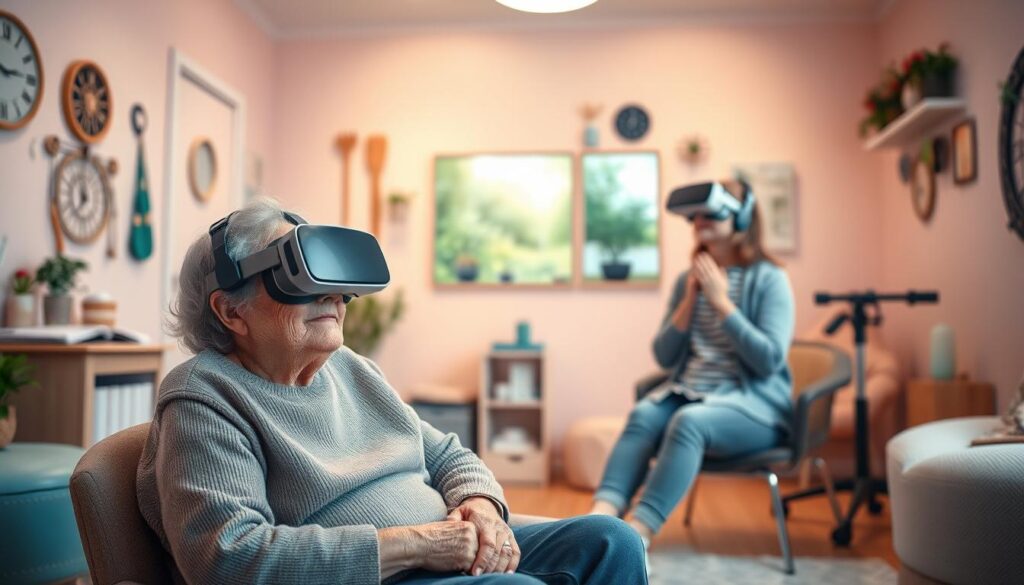
For those with dementia, immersive sessions often focus on revisiting familiar locations. A 2023 UK trial found participants recalling 34% more personal memories after six weeks of guided simulations. Clinicians report:
Autistic individuals benefit from practising interactions in adjustable scenarios. Therapists might simulate a busy café, gradually increasing noise levels as confidence grows. Key advantages include:
Home-based programmes allow extended practice between clinical visits. One NHS-backed scheme saw 72% of users transferring learnt skills to real-world situations within three months. As one carer noted: “Seeing Mum navigate the supermarket calmly after virtual rehearsals felt miraculous.”
These applications highlight how carefully designed simulations bridge therapeutic goals with daily life demands. By addressing both cognitive gaps and emotional barriers, they’re redefining support for complex neurological conditions.
Immersive tech offers fresh opportunities to expand care while confronting practical hurdles. Off-the-shelf headsets now cost less than £300, making simulated environments accessible to 63% of UK clinics surveyed by Medical News Today. Home-based programmes further reduce expenses, with some NHS trials reporting 45% lower costs compared to traditional methods.
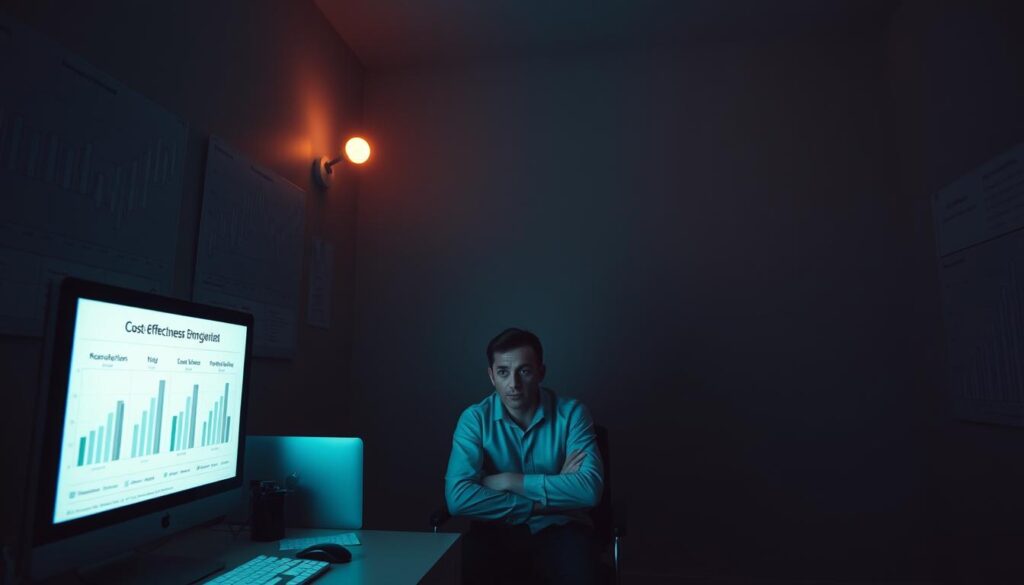
Budget-friendly headsets enable clinics to offer reality exposure therapy without expensive equipment. Studies show patients practising in digital settings require 30% fewer in-person sessions for phobia treatment. However, limited content libraries strain therapists – only 12% of UK practitioners feel current scenarios meet diverse patient needs.
Augmented reality tools enhance conventional care by overlaying calming visuals during stress management exercises. Yet 78% of clinicians cite inadequate training as a barrier. One Bristol-based scheme saw carers using pre-built simulations to ease dementia-related anxiety, demonstrating scalable potential when paired with proper guidance.
While recent trials highlight 52% faster progress in managing social fears, inconsistent content quality risks disengagement. Experts urge standardised development protocols to ensure scenarios mirror real-world challenges accurately. As one psychologist noted: “Effective care hinges on believable environments – cartoonish simulations undermine trust.”
Balancing innovation with practicality remains key. Affordable tech opens doors, but sustained success requires investment in therapist skills and evidence-based content. Ongoing research must address these challenges to unlock immersive tools’ full potential.
Cutting-edge trials demonstrate how simulated environments bridge clinical settings with everyday challenges. The gameChange initiative, involving 346 participants with psychosis, reduced avoidance of crowded spaces by 58% through gradual exposure to digital crowds. Similarly, the Phoenix programme reported 82% of users feeling more confident in job interviews after avatar-based rehearsals.
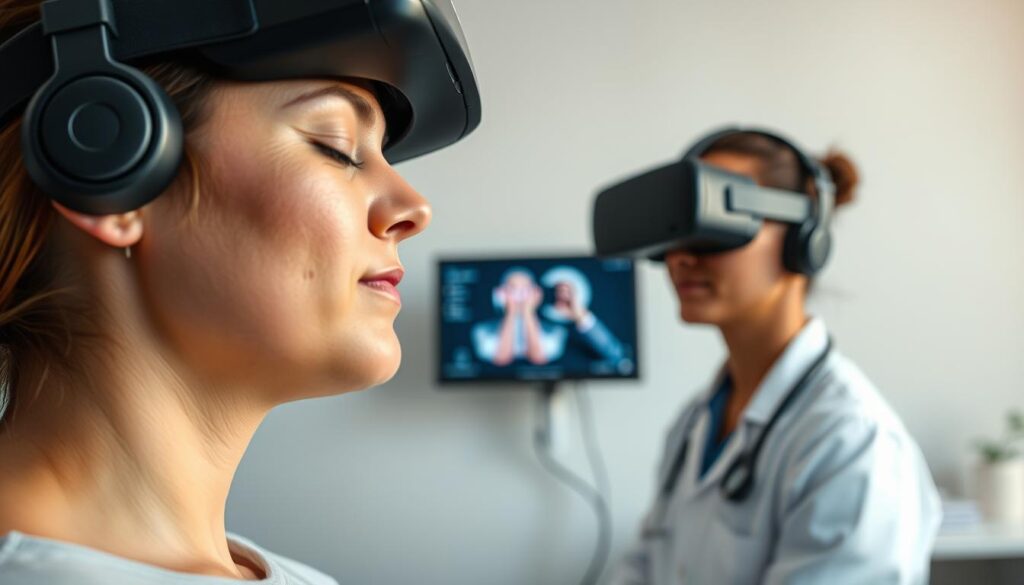
One London-based trial for social anxiety disorder saw participants complete supermarket trips 73% faster after practising in adjustable digital scenarios. “The headset let me face my fears without judgement,” shared a 34-year-old participant. Therapists observed measurable improvements in:
Health professionals increasingly combine immersive tools with cognitive behavioural techniques. A typical treatment plan might alternate reality exposure sessions with talk therapy, allowing patients to process experiences verbally. This dual approach helped 68% of agoraphobia patients in Manchester clinics resume public transport use within eight weeks.
Training remains critical – only 29% of UK clinics currently meet recommended simulation design standards. Experts advocate for certification programmes to ensure therapists can modify environments safely. As technology evolves, these blended strategies may redefine accessibility in mental health support, particularly for rural communities lacking specialist services.
The intersection of technology and mental health care continues to spark both optimism and scepticism. Studies demonstrate immersive environments can stimulate memory recall in dementia patients and help autistic individuals navigate social scenarios through controlled exposure therapy. A London trial saw participants complete anxiety-inducing tasks 73% faster after headset-based rehearsals, while 82% reported improved confidence in job interviews through avatar practice.
Successful outcomes hinge on skilled mental health professionals who blend digital tools with conventional therapies. Therapists adjust scenarios in real-time, ensuring gradual exposure to fears without overwhelming users. However, inconsistent content quality and lack training among health professionals risk undermining progress – only 29% of UK clinics meet current simulation design standards.
While evidence supports reality exposure’s effectiveness for stress disorders, long-term benefits require further study. Ongoing research and improved practitioner education could unlock this technology’s full potential. As one Bristol-based carer observed: “Seeing Dad reconnect with forgotten memories through digital walks was transformative – but we needed expert guidance every step.”
The debate between scientific promise and hyperbolic claims persists. What’s clear? When paired with human expertise, these tools offer innovative ways to bridge clinical settings with real-life challenges – reshaping care without replacing its compassionate core.